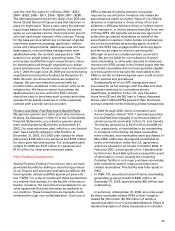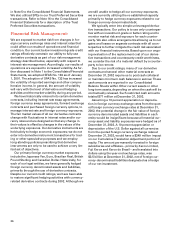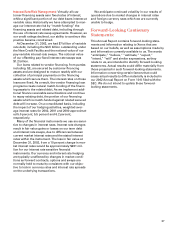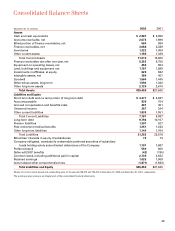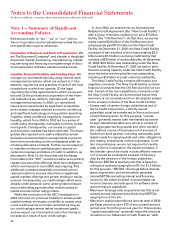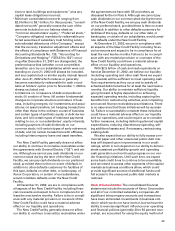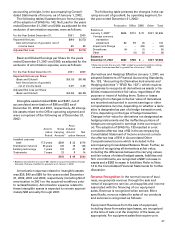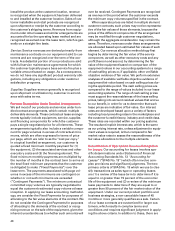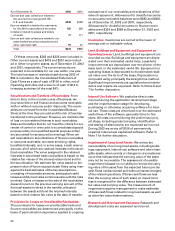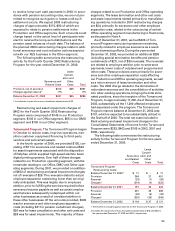Xerox 2002 Annual Report Download - page 47
Download and view the complete annual report
Please find page 47 of the 2002 Xerox annual report below. You can navigate through the pages in the report by either clicking on the pages listed below, or by using the keyword search tool below to find specific information within the annual report.
45
45”). This interpretation expands the disclosure
requirements of guarantee obligations and requires the
guarantor to recognize a liability for the fair value of the
obligation assumed under a guarantee. In general, FIN
45 applies to contracts or indemnification agreements
that contingently require the guarantor to make pay-
ments to the guaranteed party based on changes in an
underlying instrument that is related to an asset, liabili-
ty, or equity security of the guaranteed party. Other
guarantees are subject to the disclosure requirements
of FIN 45 but not to the recognition provisions and
include, among others, a guarantee accounted for as
a derivative instrument under SFAS 133, a parent’s
guarantee of debt owed to a third party by its
subsidiary or vice versa, and a guarantee which is
based on performance. The disclosure requirements of
FIN 45 are effective as of December 31, 2002, and
require information as to the nature of the guarantee,
the maximum potential amount of future payments
that the guarantor could be required to make under the
guarantee, and the current amount of the liability, if
any, for the guarantor’s obligations under the guaran-
tee. The recognition requirements of FIN 45 are to be
applied prospectively to guarantees issued or modified
after December 31, 2002. Significant guarantees that
we have entered are disclosed in Note 15. We do not
expect the requirements of FIN 45 to have a material
impact on our results of operations, financial position
or liquidity.
Stock-Based Compensation: In 2002, the FASB issued
Statement of Financial Accounting Standards No. 148
“Accounting for Stock-Based Compensation -
Transition and Disclosure, an amendment of FASB
Statement No. 123” (“SFAS No. 148”) which provides
alternative methods of transition for an entity that vol-
untarily changes to the fair value based method of
accounting for stock-based employee compensation. It
also amends the disclosure provisions of SFAS No. 123
to require prominent disclosure about the effects on
reported net income of an entity’s accounting policy
decisions with respect to stock-based employee com-
pensation. Finally, this Statement amends APB Opinion
No. 28, “Interim Financial Reporting,” to require disclo-
sure about those effects in interim financial informa-
tion. We adopted SFAS No. 148 in the fourth quarter of
2002. Since we have not changed to a fair value
method of stock-based compensation, the applicable
portion of this statement only affects our disclosures.
We do not recognize compensation expense relat-
ing to employee stock options because we only grant
options with an exercise price equal to the fair value
of the stock on the effective date of grant. If we had
elected to recognize compensation expense using a
fair value approach, and therefore determined the
compensation based on the value as determined by
the modified Black-Scholes option pricing model, the
pro forma net income (loss) and earnings (loss) per
share would have been as follows:
2002 2001 2000
Net income (loss) – as reported $91 $ (94) $ (273)
Deduct: Total stock-based
employee compensation
expense determined under
fair value based method
for all awards, net of tax (83) (93) (112)
Net income (loss) – pro forma $8 $ (187) $ (385)
Basic EPS – as reported $ 0.02 $(0.15) $(0.48)
Basic EPS – pro forma (0.09) (0.28) (0.65)
Diluted EPS – as reported 0.02 (0.15) (0.48)
Diluted EPS – pro forma (0.09) (0.28) (0.65)
As reflected in the pro forma amounts in the previ-
ous table, the fair value of each option granted in
2002, 2001 and 2000 was $6.34, $2.40 and $7.50,
respectively. The fair value of each option was
estimated on the date of grant using the following
weighted average assumptions:
2002 2001 2000
Risk-free interest rate 4.8% 5.1% 6.7%
Expected life in years 6.5 6.5 7.1
Expected price volatility 61.5% 51.4% 37.0%
Expected dividend yield –% 2.7% 3.7%
Costs Associated with Exit or Disposal Activities: In
2002, the FASB issued Statement of Financial
Accounting Standards No. 146, “Accounting for Costs
Associated with Exit or Disposal Activities” (“SFAS No.
146”). This standard requires companies to recognize
costs associated with exit or disposal activities when
they are incurred, rather than at the date of a commit-
ment to an exit or disposal plan. Examples of costs
covered by the standard include lease termination
costs and certain employee severance costs that are
associated with a restructuring, plant closing, or other
exit or disposal activity. SFAS No. 146 is required to be
applied prospectively to exit or disposal activities initi-
ated after December 31, 2002, with earlier application
encouraged. We adopted SFAS No. 146 in the fourth
quarter of 2002. Refer to Note 2 for further discussion.
Gains from Extinguishment of Debt: On April 1, 2002,
we adopted the provisions of Statement of Financial
Accounting Standards No. 145, “Rescission of FASB
Statements No. 4, 44 and 64, Amendment of FASB
Statement No. 13, and Technical Corrections” (“SFAS
No. 145”). The portion of SFAS No. 145 that is applica-
ble to us resulted in the reclassification of extraordi-
nary gains on extinguishment of debt previously
reported in the Consolidated Statements of Income
as extraordinary items to Other expenses, net. The
effect of this reclassification in the accompanying
Consolidated Statements of Income was a decrease


